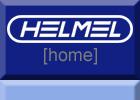|
CMMs have traditionally performed the
quality assurance function in labs and gage rooms off of, or
away from, the production floor. Today, however, we are
hearing much more discussion about putting CMMs into the
factory environment. Indeed, CMMs are finding their way into
production with varying degrees of success, but often the
implementations are the result of wishful thinking rather
than clear-headed rationality. For anyone who wants the
benefits of using standard products and software for the
flexibility, reusability, and potential costs savings
derived from placing a CMM into production, the factors for
success require fresh thinking.
Unskilled users, temperature
variations, dirt, vibration, speed, and to a lesser extent
humidity, are enemies of the CMM. These elements are
plentiful on a machine shop floor, whereas they are highly
controlled in a gage room or lab.
The "customer" for a production
shop-floor CMM is
typically a manufacturing manager or engineer, not a quality
manager or technician. He/she will be more process-oriented,
and less focused on accuracy specifications or all the
software can do, thus the CMM may be viewed as an operation
sequence in the line, i.e., "Op 40," for example. While the
function of the CMM is to ensure that parts remain within
production tolerances, in these applications it is as much
about monitoring key operations and understanding the
real-time effect of process variables on the part
dimensions. The customer wants to keep the process in
balance, and the CMM is a sensor that monitors that balance.
The users are not CMM technicians, but production line
operators who may have no more than a few minutes of
training to load and run the part. Simple user interfaces
are a necessity up front, while the metrology/programming
interface and password security protection must reside
underneath. Initial training will be forgotten after the few
needed programs are in place, so a turnkey approach
including programs and fixtures, with ongoing support, is
best. The shift in mentality from lab coats to aprons has
blindsided more than a few CMM providers.
Machining produces significant heat in
a part, moderated slightly by coolants, and thorough soaking
time is usually not practical. Most
CMMs offer some form of
temperature compensation, but these schemes can be highly
suspect. The CMM can be modeled in varying temperatures, but
a sensor for a workpiece will only report the temperature at
the point where it is attached. Most parts are not thermally
symmetrical in 3-D, so heat deformations are not evaluated,
and may have to be factored in initially. Sometimes a pre-CMM
cleaning station will be needed, and this can help to
stabilize part temperature. Inspection cycles are typically
short, from a few seconds to a couple minutes, so
time-relative temperature changes are not an issue. If a
plant is not air-conditioned, A/C for the
computer/controller may become a necessity, and incoming
airflow must be filtered.
Machining fixtures can produce
thousands of pounds of clamping force, yet CMM fixtures
produce very little holding force. Materials may be deformed
when machined "correctly," leaving features distorted when
released.
Dirt in the environment will certainly
result in erroneous measurements if not removed from the
part, but it is a bigger challenge for the CMM. Most
suppliers have by now rediscovered mechanical bearings for
their plant-floor CMMs because they are more durable, and
are better able to handle the inertia of faster speeds and
cycles, since air bearings will bottom out. Covers, bellows,
and other protections generally do a good job most of the
time, but cast-iron machining can be particularly
troublesome. Additional protection in the form of housings
or enclosures may become inevitable for the sake of the CMM.
Machining, stamping, and other
operations produce plenty of vibration, and those processes
should be floor-isolated. Still, energy can find its way
into the CMM as a source of errors, so some type of
vibration isolation is needed. Passive rubber pads or
pneumatic doughnut types are good, but active,
self-balancing, or floating isolation may not be suitable
where external automation like load/unload robots is used.
The CMM rarely stands alone, and must
interact with the outside world at some level, if only to
release clamps or open a door. CMM hardware/software must
have an I/O side that facilitates communication and data
export.
The CMM production arena is evolving,
and seeking out a supplier with experience and the
flexibility to respond to your unique needs will save much
grief in the end. |






